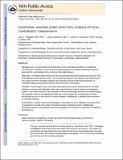| dc.contributor.author | Regatieri, Caio V. | |
| dc.contributor.author | Branchini, Lauren | |
| dc.contributor.author | Fujimoto, James G. | |
| dc.contributor.author | Duker, Jay S. | |
| dc.date.accessioned | 2012-10-15T14:53:01Z | |
| dc.date.available | 2012-10-15T14:53:01Z | |
| dc.date.issued | 2012-05 | |
| dc.identifier.issn | 0275-004X | |
| dc.identifier.uri | http://hdl.handle.net/1721.1/73959 | |
| dc.description | Author Manuscript received 2012 June 22. | en_US |
| dc.description.abstract | Background: A structurally and functionally normal choroidal vasculature is essential for retinal function. Therefore, a precise clinical understanding of choroidal morphology should be important for understanding many retinal and choroidal diseases.
Methods: PUBMED ( http://www.ncbi.nlm.nih.gov/site...) was used for most of the literature search for this article. The criterion for inclusion of an article in the references for this review was that it included materials about both the clinical and the basic properties of choroidal imaging using spectral-domain optical coherence tomography.
Results: Recent reports show successful examination and accurate measurement of choroidal thickness in normal and pathologic states using spectral-domain optical coherence tomography systems. This review focuses on the principles of the new technology that make choroidal imaging using optical coherence tomography possible and on the changes that subsequently have been documented to occur in the choroid in various diseases. Additionally, it outlines future directions in choroidal imaging.
Conclusion: Optical coherence tomography is now proven to be an effective noninvasive tool to evaluate the choroid and to detect choroidal changes in pathologic states. Additionally, choroidal evaluation using optical coherence tomography can be used as a parameter for diagnosis and follow-up. | en_US |
| dc.description.sponsorship | Research to Prevent Blindness, Inc. (United States) (Unrestricted Grant) | en_US |
| dc.description.sponsorship | National Institutes of Health (U.S.) (Contract RO1-EY11289-25) | en_US |
| dc.description.sponsorship | National Institutes of Health (U.S.) (Contract R01-EY13178-10) | en_US |
| dc.description.sponsorship | National Institutes of Health (U.S.) (Contract R01-EY013516-07) | en_US |
| dc.description.sponsorship | National Institutes of Health (U.S.) (Contract R01-EY019029-02) | en_US |
| dc.description.sponsorship | United States. Air Force Office of Scientific Research (Grant FA9550-10-1-0551) | en_US |
| dc.description.sponsorship | United States. Air Force Office of Scientific Research (FA9550-10-1-0063) | en_US |
| dc.language.iso | en_US | |
| dc.publisher | Lippincott Williams & Wilkins | en_US |
| dc.relation.isversionof | http://dx.doi.org/10.1097/IAE.0b013e318251a3a8 | en_US |
| dc.rights | Creative Commons Attribution-Noncommercial-Share Alike 3.0 | en_US |
| dc.rights.uri | http://creativecommons.org/licenses/by-nc-sa/3.0/ | en_US |
| dc.source | PubMed Central | en_US |
| dc.title | Choroidal Imaging Using Spectral-Domain Optical Coherence Tomography | en_US |
| dc.type | Article | en_US |
| dc.identifier.citation | Regatieri, Caio V. et al. “Choroidal Imaging Using Spectral-Domain Optical Coherence Tomography.” Retina 32.5 (2012): 865–876. | en_US |
| dc.contributor.department | Massachusetts Institute of Technology. Department of Electrical Engineering and Computer Science | en_US |
| dc.contributor.department | Massachusetts Institute of Technology. Research Laboratory of Electronics | en_US |
| dc.contributor.mitauthor | Fujimoto, James G. | |
| dc.relation.journal | Retina | en_US |
| dc.eprint.version | Author's final manuscript | en_US |
| dc.type.uri | http://purl.org/eprint/type/JournalArticle | en_US |
| eprint.status | http://purl.org/eprint/status/PeerReviewed | en_US |
| dspace.orderedauthors | Regatieri, Caio V.; Branchini, Lauren; Fujimoto, James G.; Duker, Jay S. | en |
| dc.identifier.orcid | https://orcid.org/0000-0002-0828-4357 | |
| mit.license | OPEN_ACCESS_POLICY | en_US |
| mit.metadata.status | Complete | |
